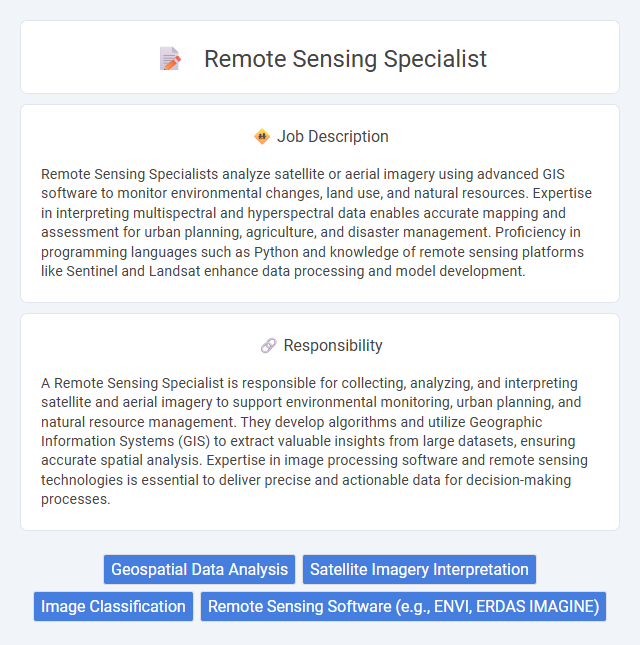
Remote Sensing Specialists analyze satellite or aerial imagery using advanced GIS software to monitor environmental changes, land use, and natural resources. Expertise in interpreting multispectral and hyperspectral data enables accurate mapping and assessment for urban planning, agriculture, and disaster management. Proficiency in programming languages such as Python and knowledge of remote sensing platforms like Sentinel and Landsat enhance data processing and model development.
Individuals with strong analytical skills and a passion for technology are likely well-suited for a Remote Sensing Specialist role, as it involves interpreting satellite or aerial data to solve environmental and geographical problems. Those comfortable working with GIS software and data modeling may find this job aligns with their skills and interests, while candidates who prefer less technical or field-oriented tasks might face challenges. A propensity for continuous learning and adaptability could increase the probability of success in this specialized and evolving field.
Qualification
A Remote Sensing Specialist requires expertise in geographic information systems (GIS), image processing software, and data analysis techniques to interpret satellite or aerial imagery accurately. Proficiency in programming languages such as Python or R enhances the ability to automate data extraction and generate actionable insights from complex datasets. Advanced degrees in geography, environmental science, or related fields combined with experience in sensor technologies and spatial modeling are essential for effective remote sensing applications.
Responsibility
A Remote Sensing Specialist is responsible for collecting, analyzing, and interpreting satellite and aerial imagery to support environmental monitoring, urban planning, and natural resource management. They develop algorithms and utilize Geographic Information Systems (GIS) to extract valuable insights from large datasets, ensuring accurate spatial analysis. Expertise in image processing software and remote sensing technologies is essential to deliver precise and actionable data for decision-making processes.
Benefit
Remote sensing specialists likely enjoy benefits such as access to cutting-edge technology and opportunities to contribute to environmental monitoring or urban planning projects. There is a probable chance they receive competitive salaries reflecting their technical expertise and analysis skills. Employers might also offer flexible work arrangements and continuous learning prospects to keep pace with evolving geospatial tools.
Challenge
A Remote Sensing Specialist likely encounters challenges in processing and interpreting large volumes of complex spatial data with high accuracy. They may face difficulties adapting to rapidly evolving technologies and integrating multi-source data for comprehensive analysis. Problem-solving skills and continuous learning appear essential to overcome these obstacles in dynamic environmental and geospatial projects.
Career Advancement
Remote Sensing Specialists advance their careers by mastering geospatial analysis, spatial data modeling, and cutting-edge satellite imaging technologies. Expertise in GIS software, machine learning integration, and environmental monitoring enhances their value in sectors like agriculture, urban planning, and defense. Continuous certification in remote sensing techniques and data interpretation fosters progression to senior analyst or project management roles.
Key Terms
Geospatial Data Analysis
A Remote Sensing Specialist with expertise in Geospatial Data Analysis utilizes satellite imagery, aerial photographs, and LiDAR data to extract actionable insights for environmental monitoring, urban planning, and natural resource management. Proficiency in GIS software such as ArcGIS, ENVI, and QGIS enables efficient processing, classification, and interpretation of multispectral and hyperspectral data. Expertise in spatial data modeling, machine learning algorithms, and data integration techniques supports accurate mapping and decision-making for diverse geospatial applications.
Satellite Imagery Interpretation
Remote Sensing Specialists expertly analyze satellite imagery to extract valuable geospatial data for environmental monitoring, urban planning, and resource management. They utilize advanced image processing techniques and software such as ENVI and ArcGIS to interpret multispectral and hyperspectral data. Proficiency in machine learning algorithms enhances the accuracy of land cover classification and change detection from satellite images.
Image Classification
Remote Sensing Specialists specializing in image classification utilize advanced algorithms and machine learning techniques to analyze satellite and aerial imagery for land cover mapping, environmental monitoring, and urban planning. Expertise in spectral analysis and multispectral/hyperspectral data processing enhances accuracy in distinguishing vegetation, water bodies, and built-up areas. Proficiency in GIS software and programming languages such as Python or R is essential for automating classification workflows and improving spatial data interpretation.
Remote Sensing Software (e.g., ENVI, ERDAS IMAGINE)
A Remote Sensing Specialist proficient in ENVI and ERDAS IMAGINE applies advanced geospatial software tools to analyze satellite and aerial imagery for environmental monitoring, urban planning, and resource management. Expertise in image processing, spectral analysis, and data integration enhances the accuracy of land use classification, change detection, and geographic information system (GIS) applications. Mastery of these remote sensing platforms accelerates decision-making by delivering precise spatial data and actionable insights.
 kuljobs.com
kuljobs.com